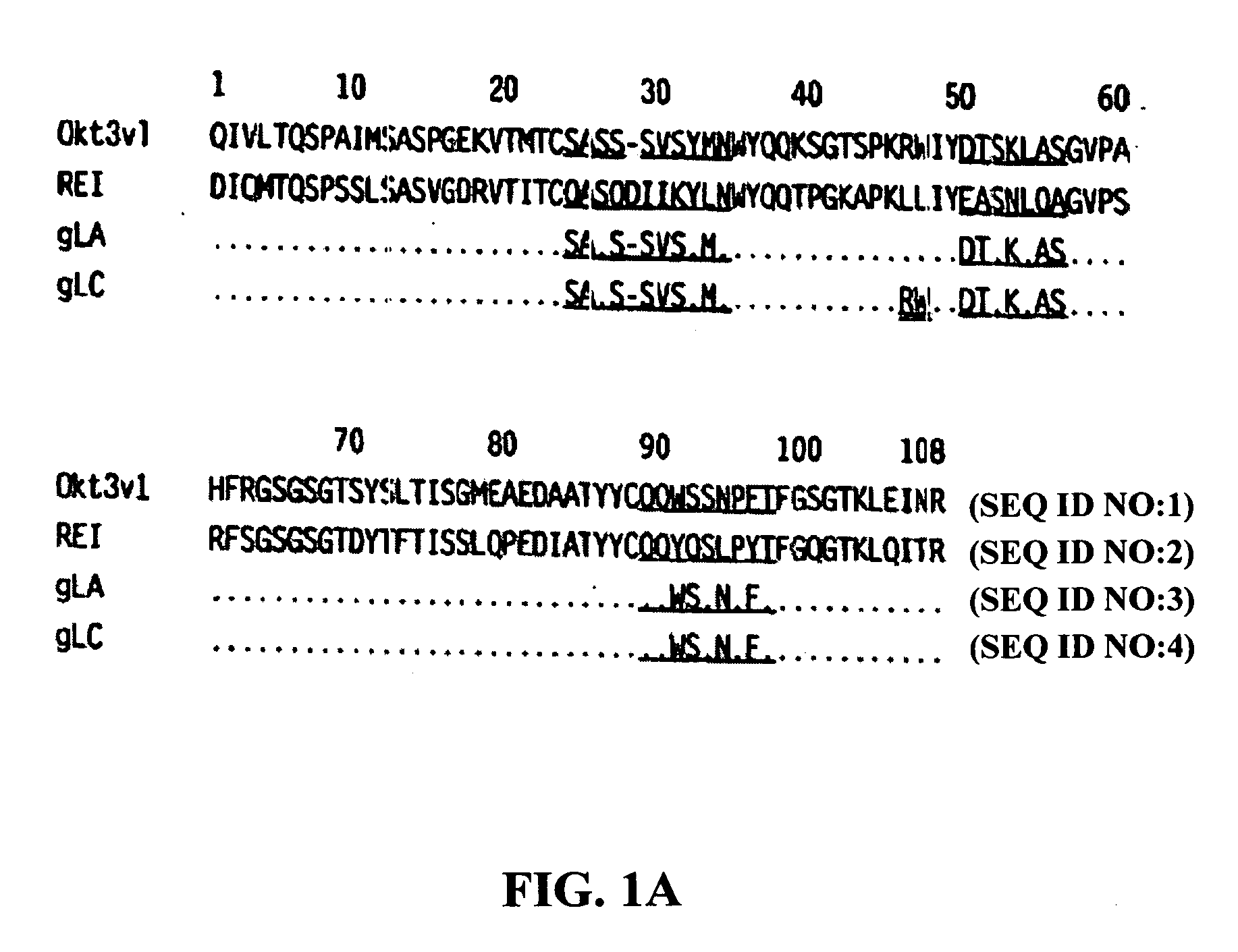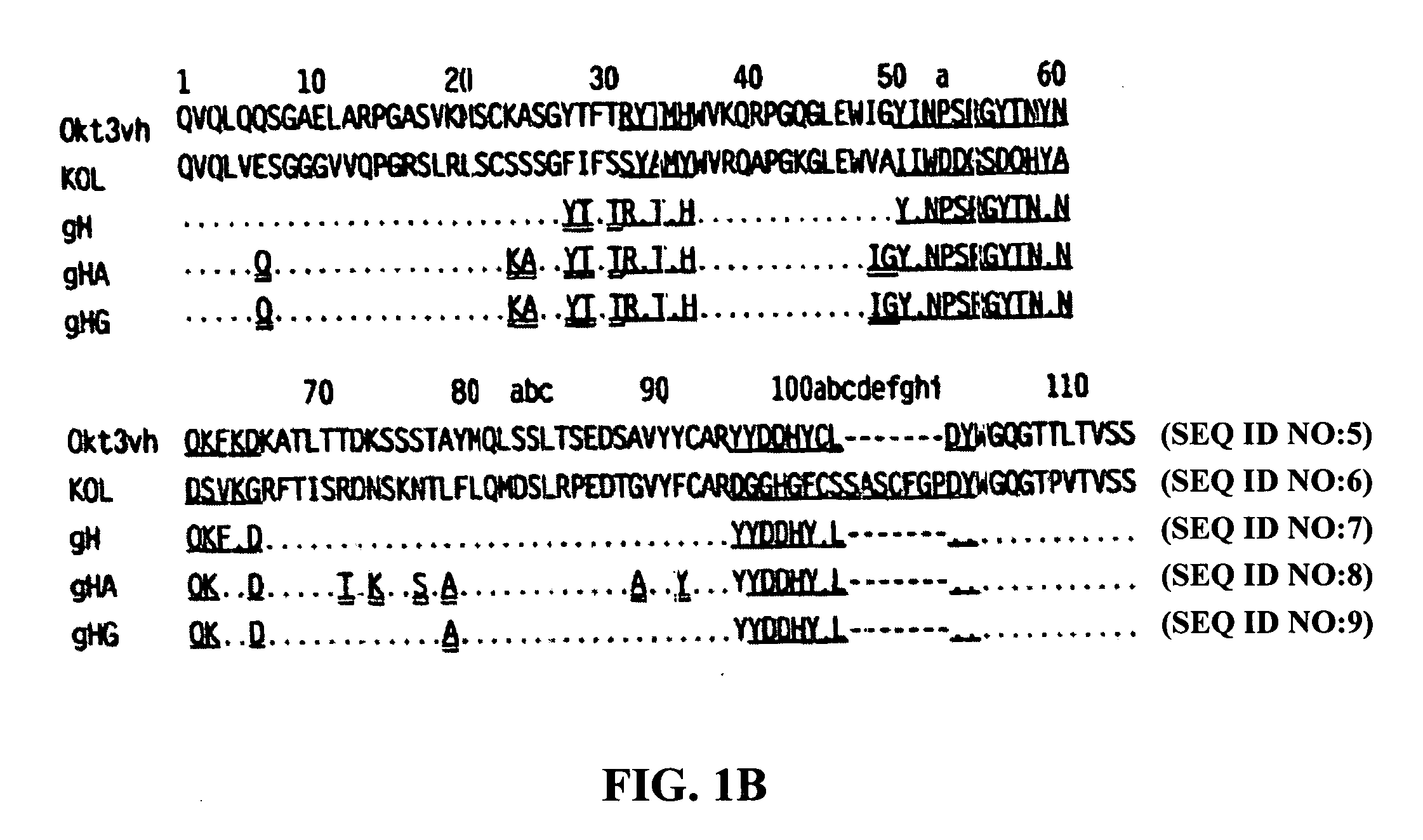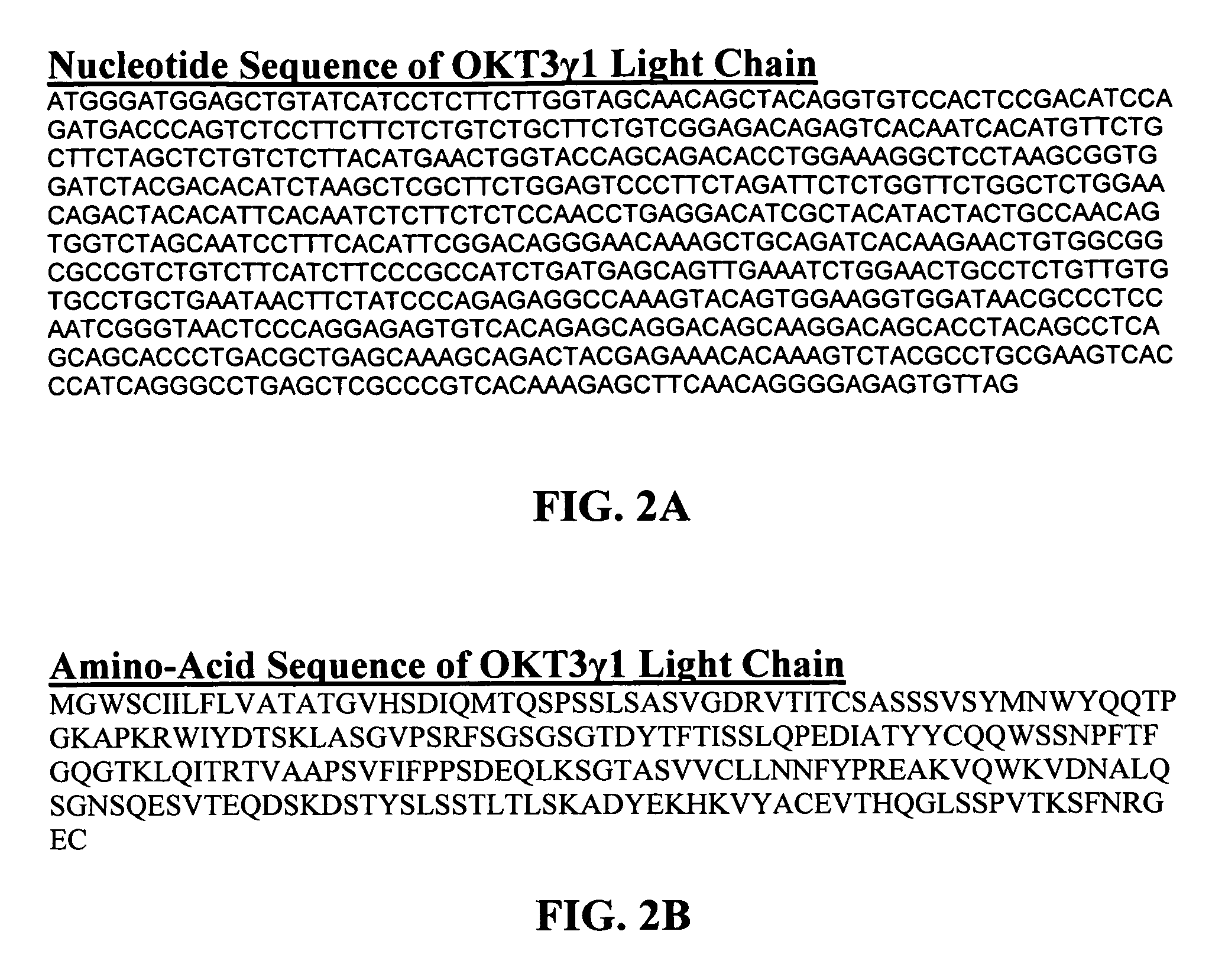[0023] The invention particularly provides methods of treating, preventing or ameliorating the symptoms of autoimmune diseases such as
Type I Diabetes,
psoriasis,
rheumatoid arthritis, lupus (particularly, cutaneous),
inflammatory bowel disease (IBD), Crohn's
disease,
ulcerative colitis,
multiple sclerosis, effects from
organ transplantation, graft vs.
host disease (GVHD), etc. Particularly, the methods of the invention are advantageous in subjects with early stage
disease to slow or reduce the damage from the
autoimmunity and maintain a high level of function and / or reduce the need for other therapy. In addition, the methods of the invention advantageously reduce the incidence of or result in no incidence of
cytokine release syndrome previously associated with administration of therapeutic antibodies, and, in particular, anti-CD3 antibodies.
Cytokine release syndrome is manifested by, for example, headache,
nausea,
vomiting, fever, myalgias, arthralgias and shaking and may be caused by increased serum levels of, for example, IL-2, IL-6, IL- 10, TNFα, and IFNγ. In certain embodiments, the methods of the invention reduce the incidence and / or reduce the severity of the symptoms of
cytokine release syndrome associated with administration of an
antibody of the invention relative a similar administration of murine OKT3. The methods also reduce the incidence and severity of other adverse effects, such as, but not limited to, EBV activation,
immunogenicity (production of anti-
idiotype antibodies, particularly IgE anti-
idiotype antibodies), lymphopenia, thrombocytopenia or
neutropenia.
[0025] In still other embodiments, the methods of the invention reduce the detectable, e.g. by ELISA, concentration of one or more cytokines in serum of a subject following the administration of one or more doses of an anti-CD3
antibody to said subject by at least about 10%, at least about 25%, at least about 50%, at least about 75%, at least about 100%, at least about 125%, at least about 150%, at least about 175%, at least about 200%, at least about 225%, at least about 250%, at least about 275%, at least about 300%, at least about 325%, at least about 350%, at least about 375%, at least about 400%, at least about 500%, at least about 600%, at least about 700%, at least about 800%, at least about 900%, at least about 1000% relative to the concentration of said one or more cytokines in serum of the subject as a result of a similar administration of murine OKT3. In another embodiment, the method of the invention reduces the detectable, e.g. by ELISA, concentration of one or more cytokines in the serum of a subject following the administration of one or more doses of an anti-CD3
antibody to said subject by at least about 1 fold, at least about 2 fold, at least about 3 fold, at least about 4 fold, at least about 5 fold, at least about 6 fold, at least about 7 fold, at least about 8 fold, at least about 9 fold, at least about 10 fold, at least about 12 fold, at least about 14 fold, at least about 16 fold, at least about 18 fold, at least about 20 fold, at least about 25 fold, at least about 30 fold, at least about 35 fold, at least about 40 fold, at least about 45 fold, at least about 50 fold, at least about 75 fold or at least about 100 fold relative to the concentration of said one or more cytokines in the serum of a subject as a result of a similar administration of murine OKT3.
[0031] In other embodiments, the methods of the invention result in a reduction in hypoglycemic episodes by 1, 2, 3, 4, 5, 6 or more episodes in a one-day, two-day, 5-day, 10-day or 15-day period as compared to similarly situated patients not having been administered the anti-CD3 antibody according to the invention.
[0036] According to the invention, the anti-CD3 antibody is administered so as to reduce adverse effects, such as the
cytokine release associated with antibody administration, EBV activation (as evidenced by EBV-induced lymphoproliferative diseases, e.g.,
mononucleosis) or lymphopenia (defined as <1000 lymphocytes / μL serum), with administration of anti-CD3 antibodies, and also reduce the number and duration of the administration. In particular embodiments, the invention provides a
treatment regimen of administration of a
dose of the anti-CD3 antibody for 2 days, 3 days, 4 days, 5 days, 6 days, 7 days, 8 days, 9 days, 10 days, 12 days, 13 days or 14 days. In preferred embodiments, the administration is carried out on consecutive days, e.g., administration occurs on at least 4 consecutive days, at least 5 consecutive days, at least 6 consecutive days, at least 7 consecutive days, at least 8 consecutive days, at least 9 consecutive days, at least 10 consecutive days, at least 11 consecutive days, or at least 12 consecutive days. In other embodiments, the administration of a
dose of the anti-CD3 antibody of the invention occurs on no more than 2 consecutive days, no more than 3 consecutive days, no more than 4 consecutive days, no more than 5 consecutive days, no more than 6 consecutive days, no more than 7 consecutive days, no more than 8 consecutive days, no more than 9 consecutive days, no more than 10 consecutive days, no more than 11 consecutive days, or on no more than 12 consecutive days. In yet other embodiments, the dosage
regimen can be 2 days or less, 3 days or less, 4 days or less, 5 days or less, 6 days or less, 7 days or less, 8 days or less, 9 days or less, 10 days or less, 11 days or less, 12 days or less, 13 days or less, or 14 days or less. In certain, embodiments, the dose administered is the same each day of the
regimen. However, in preferred embodiments the dose administered escalates over the first few days, e.g., over at least the first three days, of the
regimen to reduce or eliminate the incidence of
cytokine release syndrome.
[0042] Additionally, in certain embodiments, the invention provides methods and regimens of administering anti-CD3 antibodies that reduce the severity and / or incidence of adverse effects such as, but not limited to, cytokine release,
apoptosis, activation of EBV,
immune reaction against the anti-CD3 antibody, lymphopenia,
anemia,
neutropenia, thrombocytopenia or
secondary infection. In other embodiments, the invention provides methods and regimens of administering anti-CD3 antibodies that reduce the severity and / or incidence of adverse effects such as, but not limited to, cytokine release,
apoptosis, activation of EBV,
immune reaction against the anti-CD3 antibody, lymphopenia,
anemia,
neutropenia, thrombocytopenia or
secondary infection relative to the side effects associated with a similar regimen of administering to a subject with similar clinical parameters murine OKT3 antibody.
[0082] As used herein, the term “synergistic” refers to a combination of prophylactic or therapeutic agents which is more effective than the additive effects of any two or more single agents. A synergistic effect of a combination of prophylactic or therapeutic agents permits the use of lower dosages of one or more of the agents and / or less frequent administration of said agents to a subject with an autoimmune disorder. The ability to utilize lower dosages of prophylactic or therapeutic agents and / or to administer said agents less frequently reduces the
toxicity associated with the administration of said agents to a subjected without reducing the
efficacy of said agents in the prevention or treatment of autoimmune disorders. In addition, a synergistic effect can result in improved
efficacy of agents in the prevention or treatment of autoimmune disorders. Finally, synergistic effect of a combination of prophylactic or therapeutic agents may avoid or reduce adverse or unwanted side effects associated with the use of
combination therapy.
 Login to View More
Login to View More  Login to View More
Login to View More 


